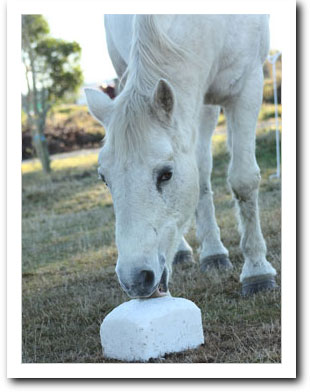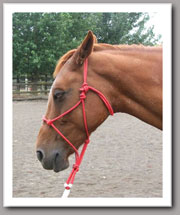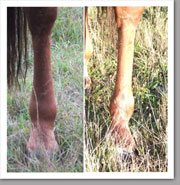The Importance of Feeding Extra Salt.
Adding salt to feeds is turning out to be the 'nutritional tip of the century'!!
Horses grazing green, growing, over-grazed or otherwise stressed grass can be ingesting many times the amount of potassium per day than they require.
As potassium is involved in cell division it is always in the tips of the leaves so in this respect short grass is worse. Also high in potassium are lucerne, molasses, protein meals and many herbs.
As grasses become higher in potassium they do not correspondingly become higher in sodium.
Lucerne and clover, being legumes store sodium in their roots while the leafy part is very high in potassium.
Spring grass has a higher water content which exacerbates the lack of sodium.
Danny (in the photograph at right) is busy licking the salt lick but this alone is NOT ENOUGH salt!
There is a lot to Know About Salt and Horses:
Understanding the following points is fundamental to keeping domestic horses calm, healthy and reproductively sound. It is particularly important as we experience a hotter than usual summer. Salt is one of the foundations of life itself and horses do not lick enough from salt licks to meet their daily requirements. Make sure they get their quota (see below) in a daily feed and by all means have a salt lick available as well.
- Salt is ‘Sodium Chloride’ not to be confused with Epsom salts which is Magnesium Sulphate – (not salt)
- Table salt is Sodium Chloride sometimes with the addition of Iodine. If you are feeding a high spec Vitamin & Mineral supplement, your horses iodine requirements will be being met. If your supplement does not contain iodine your horse will not be getting enough iodine from iodized salt.
- Salt does not ‘harden the arteries.’
- The sodium and the chloride that make up salt are ‘macro’ minerals – IE minerals which are needed in large quantities (compared to ‘trace’ minerals). Nobody can survive without salt! They are 2 of the major electrolytes (minerals dissolved in blood and body fluids which carry an electrical charge)> The other major electrolytes are potassium, calcium and magnesium. Between them, these electrolytes ultimately RUN EVERYTHING in the body.
- The horse loses approximately 20 gms of salt per day via his urine and manure even just standing at rest in the paddock! If you are not feeding at least a tablespoon of salt per day, your horse is going backwards fast. He loses even more if he sweats on a hot day or during a workout.
- A good rule of thumb for how much salt to add to feed is a minimum of 10gms per 100 kgs live weight. For example if your horse weighs 500kg, he needs approximately 50gms of salt per day – this is approximately 2 heaped tablespoons. More if he is in hard work or sweats for any other reason.
- The horse’s kidneys are very efficient at maintaining a consistent level of sodium in the body by adjusting the amount excreted in the urine.
- The Sodium part has to be a certain concentration in the body fluids. The balance between how much the horse drinks and how much he urinates is the way the body maintains the correct sodium concentrations. Failure to achieve this kicks off a cascade of metabolic malfunctions which lead to the horse becoming ‘grass-affected’.
- Lack of sodium means the thirst response is not triggered and the horse will not drink as much water. If the horse also sweats this can lead to dehydration. This is why packaged ‘electrolytes’ contain good levels of salt to replenish what has been lost. When sodium levels increase the thirst response is triggered so the body immediately takes on more water.
- Horses who sweat with very little exertion or who don’t sweat at all (anhidrosis – see post on Nov 10th) need more salt in their feed.
- Sodium is present in the extracellular fluids which bathe all the cells in the body. It is sodium that facilitates the transport of nutrients into the cells and waste products back out of the cells. If there is not enough sodium, the nutrients cannot pass through the cell membranes and therefore these cells don’t get the nutrients no matter how much you feed. This is why lack of salt is a primary cause of ‘Ill-thrift’.
- Sodium, in conjunction with potassium, is responsible for nerve impulse transmission. Sodium is also an integral player in muscle function, regulation of blood volume, blood pressure, skeletal integrity and many other roles.
- While sodium is the major cation (positively charged), Chloride is the major anion (negatively charged). Chloride is, among other things, required for maintaining correct body pH and for the manufacture of hydrochloric acid (HCl) in the stomach
- As plants have little or no need for salt, and salt is so vital to life, all mammals have an innate drive to seek it out. If there is not enough in the diet, they will lick and chew everything in sight. This is the reason horses chew things especially wood and lick your hands.
- As humans, because we like the taste, the combination of sodium being added to everything, and the fact we tend to be slack about eating enough green vegetables, we end up consuming far too much sodium compared to potassium. This can give us a mental block when it comes to feeding our horses enough salt.
- It is equally vital that your horse has access to clean fresh water because adding salt into the diet should make him want to drink more. In the hot weather, plastic water troughs, especially black ones get warm and yucky – bucket them out regularly.
You can also make ice balloons (fill a party balloon with water and freeze. Peel the rubber balloon off the ice and pop into trough) or empty a bag of ice cubes into the trough on hot days.
Symptom List...

This ‘Zonked’ Look is a classic sign of a lack of salt and is often associated
with Staggers
Signs of an excess potassium/lack of sodium imbalance include:
- Loss of appetite, weight loss, no top-line
- Dry, staring hair-coat
- Pinning their ears when asked to go
- Having absolutely 'no go’
- Excessive yawning
- Sweating with little exertion
- Sweating in odd places (on top of the neck or rump)
- ‘Stiff’, short movement (often precedes laminitis)
- Not able to canter properly, bunny-hopping, swapping leads behind
- Showing inflammation of muscles in Thermograph pictures (polymyositis)
- Saddle-fitting problems (because of above)
- Getting the shakes
- Being prone to laminitis & head-flicking
- Reproductive problems
- Retarded growth and bone development
- Standing base wide
- Wobbly especially in the hind-quarters
- Difficulty backing up
- Difficulty walking downhill
- Apathy
- Head-ache
- Abdominal bloating
- Allergies (salt is an excellent anti-histamine)
- Staggering

Same leg, 3 days apart after adding 60gms of salt / day
click on image for bigger picture.
FAQs
Is all this salt going to 'harden their arteries'?
It is not actually salt that hardens arteries, rather it is a build up of calcium plaque which occurs because of giving calcium without magnesium.
Horses are large animals and have a relatively large requirement for salt especially when green pasture or lucerne make up a high proportion of their daily forage intake, working hard, or it is hot.
When increasing salt intake it is vital to ensure access to plenty of clean water. Clean troughs regularly.
What about salt licks?
Two things:
- When the diet is high in potassium the body doesn’t always register the need for a higher salt intake.
- Horses have smooth tongues and are not inclined to lick nearly enough to cover requirements.
Best to add the basic requirement to the daily feed and have a salt lick available if they want more.
Can I offer it ‘free choice’?
Making loose salt available is an option in situations where there are multiple horses not being hard-fed. However it needs to be kept dry which is a challenge.
What about hay-fed horses?
The less green grass or lucerne in the diet, the less the potassium intake and therefore the less need to add salt to feed.
Should it be iodised salt?
Unrefined sea-salt is best but many people feed plain ‘sodium chloride’ without added iodine.
Iodine is usually supplied in Vitamin and Mineral supplements or in prepared feeds. Excess iodine intake can be a problem for broodmares.
How do I know if I am feeding too much salt?
The body will excrete it via the manure and urine so you may observe water with the stools and excessive urination.
Can you feed too much salt?
Absolutely. But it is equally harmful to feed to little. So how much is too much?
According to the latest “Nutrient Requirements of horses” a 500kg horse at rest requires 50gms (that is the 10gms per 100kg Live-Weight that we recommend) Lactating mares and horses in heavy work need more. Dr Julia Getty an eminent equine vet recommends 2oz/day, this is the equivalent of 56 gms.
A horse that consumes 10kgs of cool season pasture grass will get about less than one gram of salt from that grass. Remember grass has NO requirement for salt so doesn’t bother to uptake it. Grass has no interest in the health of your horse or whether you and your horse have a terrible time or not!
From the same amount of grass the horse will get about 300gms of potassium.
It is crucial for life that the horse’s blood and body fluids maintain about twice, no more than 5 x the amount of potassium as sodium. This is the job of the adrenal glands and the kidneys.
It is not rocket science that if the horse is subject to this chronic imbalance every day of his life that he will cope for awhile (sometimes they appear to cope for years) but eventually the adrenals and the kidneys can’t keep up and horses show the outward signs of being grass-affected that most of us are very familiar with.
As soon as you add salt to the feed this takes the pressure off his adrenals and kidneys and eases the situation for him.
The thing to understand about salt (the sodium component in particular) is that it has to be at a certain concentration in the blood and body fluids. If you eat too much salt you trigger the thirst response and you will go and drink some water. This maintains the correct concentration. If you drink lots and lots of water without increasing salt intake you will be in metabolic trouble and can have seizures and die!
So while horses have a good tolerance for a good intake of salt, so long as they have access to clean drinking water (that isn’t too cold) it is best not to go overboard with it either.
 Calm Healthy Horses
Calm Healthy Horses